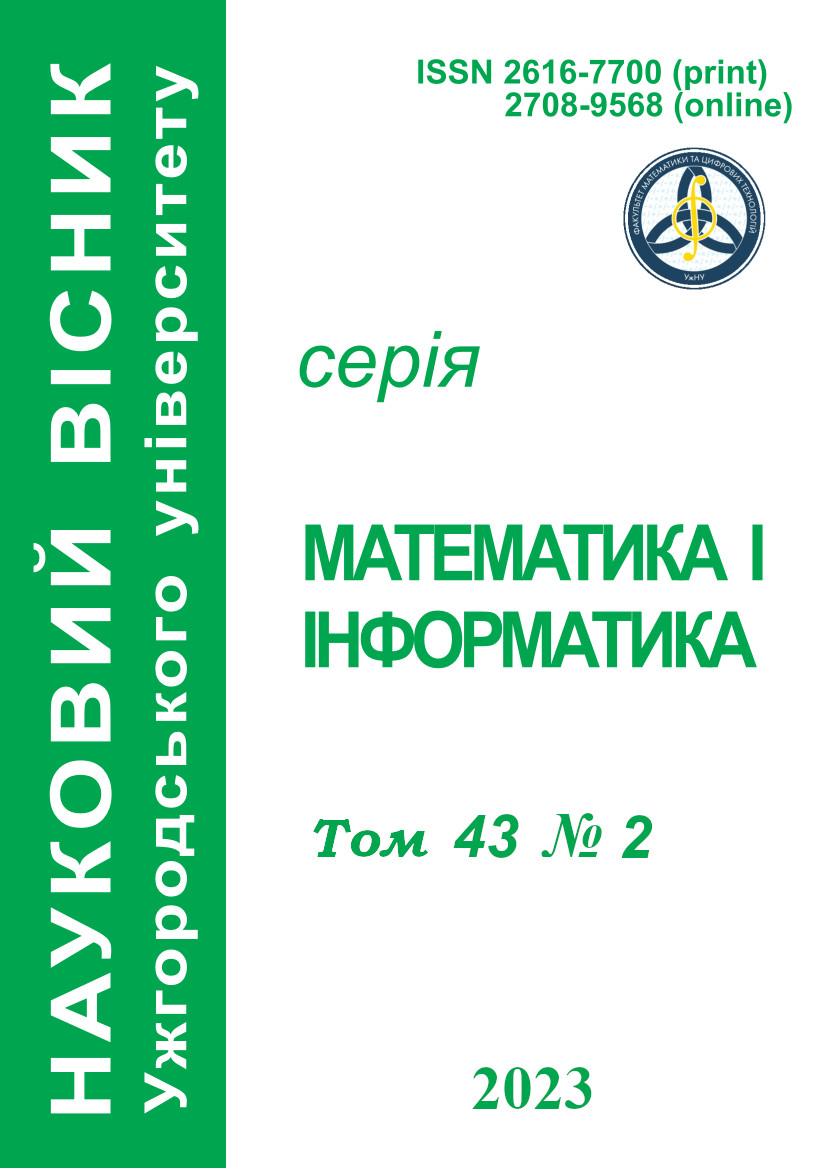Використання математичного апарату та ІКТ для розв'язання прикладних задач
DOI:
https://doi.org/10.24144/2616-7700.2023.43(2).119-129Ключові слова:
освітній процес, прикладні задачі, інформаційні-комунікаційні технології, цифровізація, інженерні завдання, центр мас, ферма, MapleАнотація
У сучасному інформаційному суспільстві, де кількісні дані та обробка інформації відіграють ключову роль, використання математичного апарату та інформаційно-комунікаційних технологій (ІКТ) стає необхідністю. Це є надзвичайно важливим для моделювання, розв'язання складних прикладних задач у наукових дослідженнях і виробничій діяльності.
У роботі досліджено особливості математичної підготовки студентів інженерних спеціальностей і розглянуто можливості вдосконалення освітнього процесу шляхом застосування ІКТ. Авторами підкреслено роль і важливість застосування математичного апарату та інформаційно-комунікаційних технологій при розв’язанні практичних завдань у різних галузях. У статті наведено деякі приклади математичних задач, які застосовуються при розв’язанні інженерних завдань. Використання таких задач при вивченні курсу вищої математики демонструє зв’язок теорії з практикою й сприяє підвищенню мотивації до вивчення математики та застосуванню математичного апарату при дослідженнях виробничих процесів.
Для поліпшення ефективності навчання, авторами запропоновано шляхи оптимізації освітнього процесу та можливості використання сучасних інформаційних технологій для розв'язання практичних завдань.
Посилання
- Kaznadiy, S. P., Murashkowska, V. P., & Runovska, L. A. (2016). The use of computer technologies in the educational process. Pedagogical Sciences: Theory, History, Innovative Technologies, 2, 263–269.
- Ichanska, N., & Shurpyk, O. (2022). Information technologies in teaching higher mathematics. Methodology of modern scientific research. Collection of scientific works based on the results of the XVIII International scientific and practical conference dedicated to the 300th anniversary of H. S. Skovoroda. Kharkiv [in Ukrainian].
- Ichanska, N. V. (2020). Educational Internet resources and online environments in the educational activity of a teacher of a higher education institution. Control, navigation and communication systems, 4(62), 40–42. https://doi.org/10.26906/SUNZ.2020.4.040
- Levchuk, O. V., Dzis, V. G., & Novytska, L. I. (2013). Higher mathematics using MATHCAD: a guide for universities. Vinnytsia: VNAU [in Ukrainian].
- Krupsky, I. (2011). Problems of effective work of students during the use of educational Maple simulators for step-by-step solutions of typical problems of higher mathematics. Collection of scientific papers of the Uman State Pedagogical University. Part 3, 130–135. Retrieved from: http://nbuv.gov.ua/UJRN/znpudpu_2011_3_19
- Onyshchenko, V., Ichanska, N., Skryl, V., & Furmanchuk, O. (2022). Economic and Mathematical Modeling of Innovative Development of Enterprises in the Construction Industry. In: Onyshchenko, V., Mammadova, G., Sivitska, S., Gasimov, A. (eds.). Proceedings of the 3rd International Conference on Building Innovations. Lecture Notes in Civil Engineering. Vol. 181. Springer: Cham. https://doi.org/10.1007/978-3-030-85043-2_65
- Mykhalevych, V. M., & Krupskyi, Y. V. (2010). Improving the efficiency of independent educational and cognitive activity of students using Maple technologies. Scientific Bulletin of the National Pedagogical University named after M. P. Dragomanov. Series 5. Pedagogical Sciences: Realities and Prospects, 22, 285–290 [in Ukrainian].
- Mikhalevich, V. M. (2016). The use of computer mathematics systems in the process of education of university students: monograph. Vinnytsia: VNTU [in Ukrainian].
- Morze, N. V., & Kocharyan, A. B. (2014). The model of the ICT competence standard of university teachers in the context of improving the quality of education. Information Technologies and Learning Tools, 43(5), 27–39.
- Klochko, V. I. (1997). The use of advanced information technologies in the study of higher mathematics in a technical university: Educational-methodical manual. Vinnytsia: VNTU [in Ukrainian].
- Spivakovsky, O. V. (2003). Theory and practice of using information technologies in the process of training students of mathematical specialties: a monograph. Kherson: Aylant [in Ukrainian].
- Tryus, Y. V. (2005). Computer-oriented methodical systems of teaching mathematics: monograph. Cherkasy: Brama-Ukraine [in Ukrainian].
- Morokhovets, H. Yu. (2017). Developing the Professional Competence of Future Doctors in the Instructional Setting of Higher Medical Educational Institutions. Wiadomości Lekarskie, LXX(1), 101–104.
- Sinytsia, M. O. (2014). The use of multimedia technologies in the educational process of universities as a means of forming pedagogical knowledge. In Professional pedagogical education: formation and development of pedagogical knowledge: monograph (418–438). Zhytomyr: Department of the State University named after I. Franka [in Ukrainian].
- Ichanska, N., & Sirovyi, S. (2020). The use of educational internet resources in teaching foreign students. Systems of Control, Navigation, and Communication. Collection of Scientific Works, 3(61), 86–89.
- Horyk, A. V., Piskunov, V. G., & Serov, N. I. (2002). Analytical solution of the problem of bending of non-uniform non-circular cylindrical bodies. International Applied Mechanics, 38, 1261–1271.
- Horyk, A. V., Piskunov, V. G., & Serov, N. I. (1999). Analytical solution of the problem of bending of a composite beam based on an improved deformation model. Force of Materials, 31, 85–98.
- Sakhnovsky, M. M. (1975). Chapter IV "Calculation of construction of joints and elements of welded structures". § Farms. Handbook of the designer of construction welded structures. Dnipropetrovsk: "Ray" [in Ukrainian].
- Drozdenko, V. O. (2019). Maple in mathematics: a study guide for students of higher educational institutions of III and IV levels of accreditation. Bila Tserkva [in Ukrainian].
- Makhnei, O. V., & Hoi, T. P. (2013). Mathematical support of automation of applied research: study guide. Ivano-Frankivsk: Simyk [in Ukrainian].
##submission.downloads##
Опубліковано
Як цитувати
Номер
Розділ
Ліцензія
Авторське право (c) 2023 Н. В. Ічанська, Д. Ю. Лозицький

Ця робота ліцензується відповідно до Creative Commons Attribution 4.0 International License.
Автори залишають за собою право на авторство своєї роботи та передають журналу право першої публікації цієї роботи на умовах ліцензії Creative Commons Attribution License, котра дозволяє іншим особам вільно розповсюджувати опубліковану роботу з обов'язковим посиланням на авторів оригінальної роботи та першу публікацію роботи у цьому журналі.








